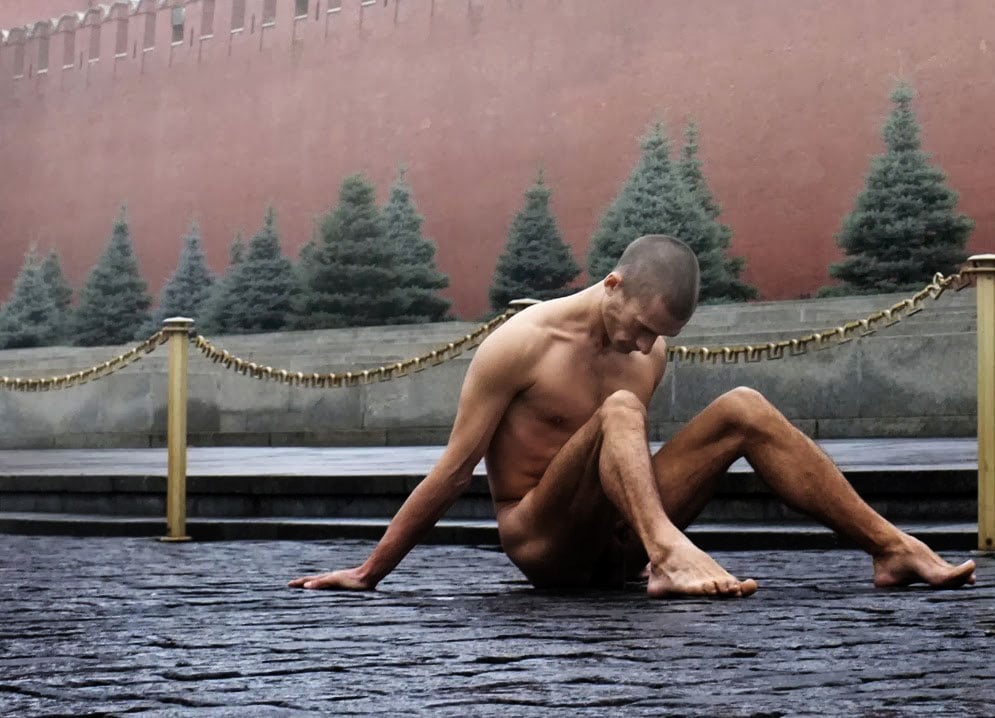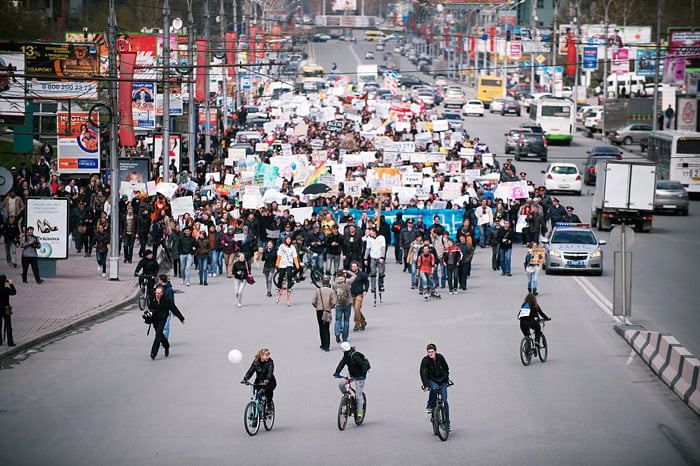The body politic: how Pyotr Pavlensky’s performance art is breaking the mould

Pyotr Pavlensky, whose 'living-pain sculptures' have made headlines round the world, is the latest in a long line of Russian actionists. But his uncompromising views on the autonomy of the artist set him apart from his predecessors
In recent months it has become common in Russia to pronounce the death of the oppositional actionist movement that flourished between 2007-2012 with the likes of Pussy Riot and the Voina group. When a St Petersburg activist-artist swam the Fontanka in August with a sign reading “Putin is Eternal/Crippled” (a play on the Russian vechen/uvechen), he expressed astonishment at the lack of media response, going so far as to compare post-Bolotnaya Russia to North Korea in its ability to ignore such interventions. Perhaps, he reasoned, truly high-profile actions are only possible under soft authoritarian regimes like that of the Medvedev presidency. Pussy Riot’s Nadya Tolokonnikova has expressed similar sentiments, blaming not the media (an obvious culprit considering the level of state control), but the regime’s turn from its original emphasis on “stability” to aggressive popular mobilisation, which reached a frenzied peak after the annexation of Crimea. What can radical art actions achieve when the state itself is pushing all the trigger points and provoking conflict?
Still, a lone hope remains: Pyotr Pavlensky rose to prominence in 2012 with Stitch, sewing his mouth shut to protest the Pussy Riot trial, and went on to produce two more living-pain sculptures with Carcass — wrapping himself, naked, in barbed wire to symbolise Russia’s repressive legal system — and, the highest-profile of all, Fixation, nailing his scrotum to Moscow’s Red Square in protest against the “apathy, political indifference and fatalism of contemporary Russian society”. Last month, Pavlensky struck again, slicing off his earlobe while sitting atop the infamous Serbsky institute for forensic psychiatry in Moscow, where many a dissident was declared mentally ill for non-conformist beliefs during Soviet times. The work was called Otdelenie, which means “separation”, but also a department or subdivision, including a hospital ward. (Pavlensky himself was forced to undergo psychiatric evaluation after each of his first three works.)
 Stitch (2012) Photograph: Gleb Haski
Stitch (2012) Photograph: Gleb Haski
Unlike an earlier generation of Russian actionists, who often revelled in ambiguity, Pavlensky has a passion for firm boundaries, particularly in the struggle between state and artist. He has said as much in a number of recent public statements, including two interviews, one following a visit to Kiev’s Maidan Square in December 2013, and more recently with RFE/RL’s Dmitry Volchek. In calling for this strict divide, Pavlensky referred to Manifesta 10, the European biennial of contemporary art that wrapped up last month in St Petersburg, as political prostitution — mere decoration for the regime — and broadly defined art as any and all emancipatory practice. He saw the Maidan uprising as the true festival of revolt that artists should look to for inspiration; in February he and other activists created a burning barricade on St Petersburg’s Malo-Konyushenny Bridge with Liberty, mimicking the Maidan events. With this, a new turn seemed visible in Pavlensky’s work — “speaking,” as he put it, “for the first time about freedom and not prison”.
Pavlensky’s unconditional support for Maidan distinguishes him from the many Russian actionists and performance artists — like Oleg Vorotnikov of Voina — who have expressed enthusiasm for the Crimean annexation. Such attitudes resonate interestingly with Tolokonnikova’s argument: like the “total-artist” Stalin, whom critic and theorist Boris Groys describes as having realised the avant-garde dream of transforming life, today’s newly aggressive Russia has taken up the mantle of the actionists, far surpassing its teachers when it comes to undermining the political order — in this case, the geopolitical order of the smug liberal west.
 Carcass (2013) Photograph: Maxim Zmeev
Carcass (2013) Photograph: Maxim Zmeev
Pavlensky, on the contrary, sees himself and the state squarely on opposite sides of the barricades. This position of unbending confrontation with those in power has a distinguished ancestry in political theory. From Georges Sorel, who argued that the proletariat should answer all gestures of compromise from the bourgeoisie with “black ingratitude,” to Frantz Fanon’s celebration of violent conflict with the coloniser as a means of political subjectivation, many have argued that a resistance movement must maintain the force and ferocity of its dialectical encounter with the oppressor to the bitter (or ecstatic) end. Otherwise the dynamic of contradiction fails, leaving us stranded in yet another frozen conflict, “fixated” by defeat.
What is peculiar about Pavlensky’s position, however, is his identification of such non-cooperation with the autonomy of art. After Liberty he was questioned by police and published dramatised transcripts of the interrogation. In these (it is not clear how much editing or invention they include), the character “Pavlensky” takes an exceedingly defensive posture, resisting all attempts by the “investigator” to blur the lines between the actionist’s practice and his own (at one point the investigator even calls himself an “artist of justice”). At every turn Pavlensky seeks to uphold and protect the authority of art’s autonomous law from that of the state. If the cop wants to be an artist, he must enrich art’s symbolic codes, conceptualise his work within the narratives of art history, and communicate his message to an audience, particularly the fact that he is engaged in producing art. He must overcome himself like any true artist by doing something others (the rest of us plebeians) find impossible. Meanwhile, the investigator gradually moves in the opposite direction, admitting that the law he embodies is empty, that he is only an instrument, that his own moment of historical accountability is coming (the investigator in fact lost or left his job soon after the drama was published), that he has no idea what forces are behind the investigation, and the best bit of all — that “everyone says: we have capitalism. But in America they have democracy… But it’s actually a lot stricter there. Really, a lot stricter and more brutal.”

Caught in the maw of power’s unintelligibility, the sentimental cop still wants to believe in a soft authoritarianism that might protect him from the coming flood. Pavlensky, by contrast, wants something harder. He decries the compromises of contemporary Russians — particularly oppositional artists who have participated in Manifesta — repeatedly diagnosing such behaviour as “schizophrenic”. But isn’t this a call for the same kind of disciplinary clarity — the segregation of the insane from the sane — that he critiques in Otdelenie? Choose sides, no compromises — enough madness. Though cutting off his earlobe involved an homage to Vincent van Gogh, Pavlensky’s call for clear boundaries is far removed from the painter, who famously gave his ear to a prostitute, saying “Guard this object carefully,” thus passing the artwork (the ear) from one place of segregation to another — from madness to illicit desire. But Pavlensky passes his ear from art’s place of power to that of the police: you have your law, and I have mine. And the object itself is lost: “I didn’t get my knife or my earlobe back,” Pavlensky wryly commented after the action.
One of the most potent aspects of the Russian actionist tradition — from late Soviet practioners like the Necrorealists, to the Moscow actionists in the 1990s, and up to Voina in the 2000s — was its passion for ambiguity and “zones of indistinction” (a term popularised by the Collective Actions group in the 1970s long before philosopher Giorgio Agamben used it to define the juridico-political order of our times). Occupying spaces between life and death, human and animal, or, indeed, aesthetic autonomy and activist engagement, this tradition flourished though emancipatory enjoyment of every category’s slippage, every law’s emptiness. Vorotnikov’s support for the annexation is true to Voina’s boisterous overidentification with state power within such zones of indistinction (best realised in the action A Cop in a Priest’s Cassock). But it is also a political error: When the state is creating these zones, the artist becomes irrelevant, and one can hardly speak of emancipation.
 Liberty (2014) Photograph: Maxim Zmeev
Liberty (2014) Photograph: Maxim Zmeev
Despite his deep roots in this larger Russian tradition, Pavlensky has embraced neither indistinction nor festiveness. Even his Liberty — meant to imitate the great “festival” of Maidan — seemed a rather gloomy affair. Still, one wonders how genuine his insistence on artistic autonomy really is. In fact, his statements on the relationship between art and politics often verge on their own kind of schizophrenia. Maidan is a total installation, he tells us. This could mean the distinction between art and politics no longer exists, but it is also a strangely contemplative act of aestheticisation, lifting the revolt out of the immediacy of struggle. The signature of one of his investigators uncannily resembles the form of his Carcass. Perhaps this is evidence, as Pavlensky claims, that he is unmasking the hidden codes of power. But the gesture also falls into line with his virtuoso ability to draw the police into the frame of his artworks and “recode” them in his own way. Volchek compares Pavlensky’s work to the end of Vladimir Nabokov’s Invitation to a Beheading (and the artist approves), when Cincinnatus realises his prison and jailers are only a poorly constructed illusion and the true “reality” is a higher-level work of artistic imagination (the novel itself). But doesn’t such a radical retreat into art contradict Pavlensky’s own references to Kazimir Malevich, who defined art’s truth as a power and mastery possible only through the rejection of autonomy, creating the forms of nature directly? All of these contradictions seem to escape Pavlensky’s notice, and perhaps this is a good thing. Behind his insistence on the iron law of art, there seems to be a good deal of slippage after all.
Once, while performing an impromptu punk concert in the Tagansky courthouse during the Forbidden Art exhibition trial, Voina told us, “All cops are bastards, remember this.” When the cop-bastards then rushed in to stop the show, they ended up joining it, forming a mosh pit with the artists (and I swear they were enjoying themselves). Following Voina’s example, Pavlensky’s actions always hinge on the moment the police arrive — a moment of great festive potential. This is when we lose our bearings regarding the question of Kto kogo? (Who’s the boss here?) — asking who the real “victim” is in the action, the artist or the baffled police who have to decide what to do with him. But Pavlensky is deadly serious at these moments, as he almost always is. Isn’t it possible to remember who the bastards and prostitutes are, and yet still join them in the dance? For, at the end of the day, the dance of indistinction is a truly subversive site — a site where power and the law collapse, where emancipatory practice confronts the bastard and prostitute in each of us, forcing us all to question our lineage and the cost of our desire.



